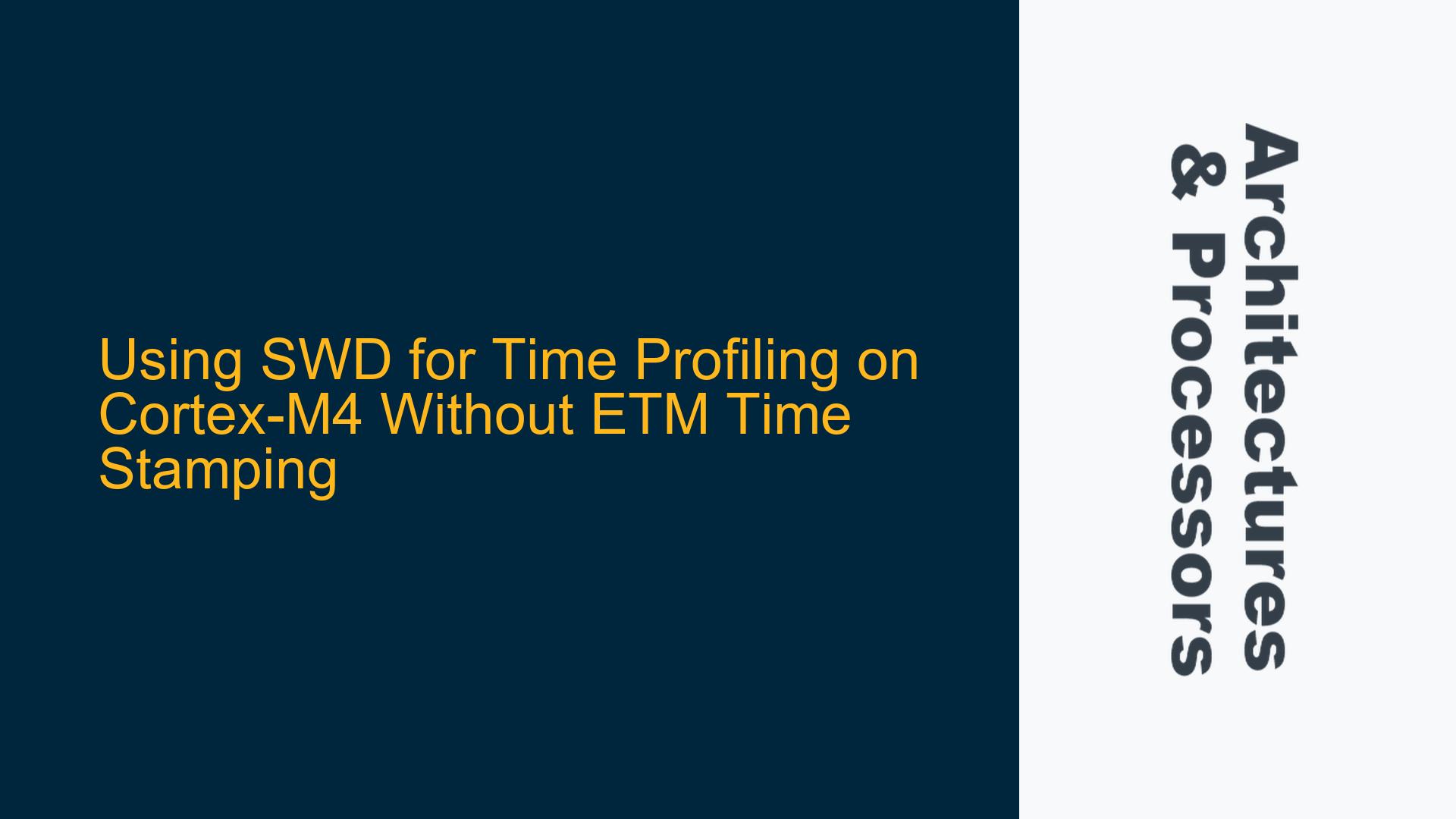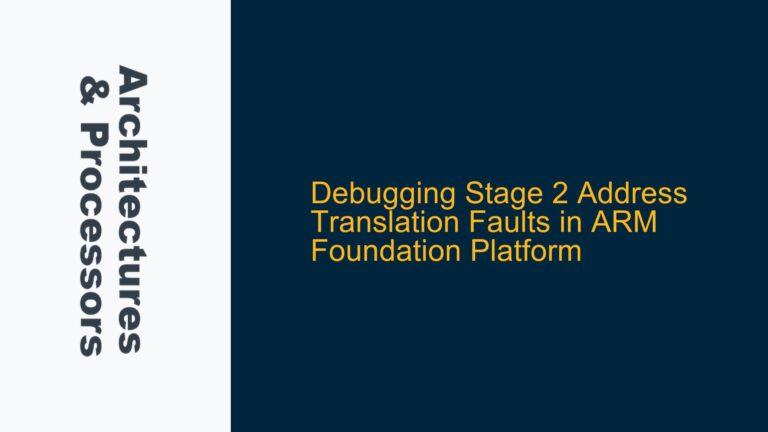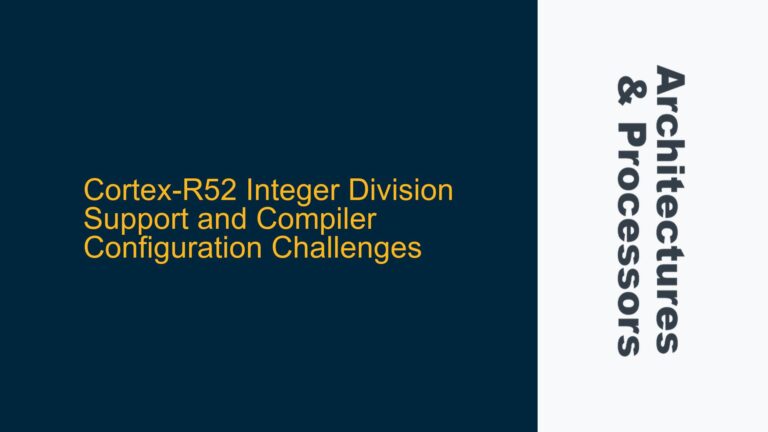ARM Cortex-M4 Time Profiling Challenges Without ETM Support
The ARM Cortex-M4 microcontroller, such as the LPC4370, is widely used in real-time applications due to its balance of performance and power efficiency. However, one of the challenges developers face is accurately measuring the execution time of specific functions, especially when the microcontroller lacks Embedded Trace Macrocell (ETM) support. ETM provides detailed trace information, including time-stamped execution traces, which are invaluable for performance analysis. In the absence of ETM, developers often turn to alternative methods, such as using the Serial Wire Debug (SWD) interface, to achieve similar results.
The SWD interface is a two-pin debug protocol that provides access to the ARM CoreSight Debug and Trace functionality. While SWD is primarily used for debugging, it can also be leveraged for performance profiling. However, using SWD for time profiling requires a deep understanding of the Cortex-M4 architecture, the SWD protocol, and the specific capabilities of the microcontroller in question. The LPC4370, for instance, does not support ETM, which means that traditional time-stamping methods are unavailable. This limitation necessitates a more creative approach to time profiling, one that relies on the available debug resources and the microcontroller’s internal timers.
The Cortex-M4 core includes a Data Watchpoint and Trace (DWT) unit, which can be used to monitor various events, including instruction execution, data accesses, and exceptions. The DWT unit also includes a cycle counter, which can be used to measure the execution time of code segments. However, the DWT cycle counter is not directly accessible via the SWD interface, which means that additional steps are required to use it for time profiling. Furthermore, the accuracy of the DWT cycle counter depends on the configuration of the microcontroller’s clock system, as well as the presence of any interrupts or other events that might affect the execution time of the code being profiled.
In addition to the DWT unit, the Cortex-M4 core includes a Instrumentation Trace Macrocell (ITM), which can be used to generate trace data that includes time-stamped events. However, the ITM requires a separate trace output pin, which may not be available on all microcontrollers. In the case of the LPC4370, the ITM is not available, which further complicates the task of time profiling. Despite these limitations, it is still possible to use the SWD interface in conjunction with the DWT cycle counter to measure the execution time of specific functions, provided that the necessary steps are taken to configure the debug interface and the microcontroller’s internal timers.
SWD Protocol Limitations and DWT Cycle Counter Configuration
The SWD protocol is a powerful tool for debugging ARM microcontrollers, but it has certain limitations when it comes to time profiling. One of the primary limitations is that the SWD interface does not provide direct access to the DWT cycle counter. Instead, the DWT cycle counter must be accessed indirectly through the Debug Access Port (DAP), which is the interface between the SWD protocol and the microcontroller’s debug resources. This indirect access introduces additional latency, which can affect the accuracy of time measurements, especially when measuring short code segments.
Another limitation of the SWD protocol is that it does not provide real-time access to the DWT cycle counter. Instead, the DWT cycle counter must be read periodically, which means that the time measurements are not continuous. This limitation can be mitigated by using a combination of the DWT cycle counter and the microcontroller’s internal timers, but this approach requires careful configuration of both the debug interface and the timers.
The DWT cycle counter is a 32-bit counter that increments with each clock cycle of the Cortex-M4 core. The counter can be used to measure the execution time of code segments by reading the counter before and after the code segment and calculating the difference between the two values. However, the DWT cycle counter must be enabled and configured before it can be used. This configuration involves setting the appropriate bits in the DWT Control Register (DWT_CTRL), which is part of the DWT unit.
In addition to enabling the DWT cycle counter, it is also necessary to configure the microcontroller’s clock system to ensure that the DWT cycle counter is incremented at the correct rate. The Cortex-M4 core can operate at different clock frequencies, depending on the configuration of the microcontroller’s clock system. The DWT cycle counter is incremented at the same rate as the core clock, which means that the accuracy of the time measurements depends on the stability of the core clock. If the core clock frequency changes during the execution of the code segment being profiled, the time measurements will be affected.
To ensure accurate time measurements, it is also necessary to disable interrupts during the execution of the code segment being profiled. Interrupts can cause the Cortex-M4 core to switch to an interrupt service routine (ISR), which can affect the execution time of the code segment. Disabling interrupts ensures that the code segment is executed without interruption, which allows for more accurate time measurements. However, disabling interrupts can also affect the real-time behavior of the application, so it is important to carefully consider the trade-offs when using this approach.
Implementing SWD-Based Time Profiling with DWT Cycle Counter
Implementing SWD-based time profiling on a Cortex-M4 microcontroller without ETM support involves several steps, including configuring the SWD interface, enabling and configuring the DWT cycle counter, and reading the cycle counter values before and after the execution of the code segment being profiled. The following steps provide a detailed guide on how to implement SWD-based time profiling on the LPC4370 microcontroller.
First, it is necessary to configure the SWD interface to enable access to the DWT unit. This configuration involves setting up the Debug Access Port (DAP) and configuring the SWD protocol to communicate with the DWT unit. The DAP is the interface between the SWD protocol and the microcontroller’s debug resources, and it must be configured to allow access to the DWT unit. This configuration typically involves setting the appropriate bits in the DAP Control Register (DAP_CTRL), which is part of the DAP.
Once the SWD interface is configured, the next step is to enable and configure the DWT cycle counter. This involves setting the appropriate bits in the DWT Control Register (DWT_CTRL) to enable the cycle counter and configure its behavior. The DWT_CTRL register includes several bits that control the behavior of the cycle counter, including the CYCCNTENA bit, which enables the cycle counter, and the CYCCNTINIT bit, which initializes the cycle counter to a specific value. It is also necessary to configure the DWT cycle counter to increment at the correct rate by ensuring that the core clock frequency is stable and correctly configured.
After the DWT cycle counter is enabled and configured, the next step is to read the cycle counter values before and after the execution of the code segment being profiled. This involves using the SWD interface to read the DWT Cycle Counter Register (DWT_CYCCNT), which contains the current value of the cycle counter. The cycle counter value should be read immediately before the code segment is executed and immediately after the code segment is executed. The difference between the two values represents the number of clock cycles that elapsed during the execution of the code segment.
To convert the cycle count into a time measurement, it is necessary to know the core clock frequency. The core clock frequency can be determined by reading the appropriate registers in the microcontroller’s clock system. Once the core clock frequency is known, the time measurement can be calculated by dividing the cycle count by the core clock frequency. For example, if the core clock frequency is 100 MHz and the cycle count is 1000, the execution time of the code segment is 10 microseconds.
It is also important to consider the impact of interrupts on the time measurements. As mentioned earlier, interrupts can affect the execution time of the code segment being profiled. To ensure accurate time measurements, it is necessary to disable interrupts during the execution of the code segment. This can be done by setting the appropriate bits in the Cortex-M4’s Interrupt Control and State Register (ICSR) to disable interrupts. However, disabling interrupts can affect the real-time behavior of the application, so it is important to carefully consider the trade-offs when using this approach.
In addition to disabling interrupts, it is also important to consider the impact of other events that might affect the execution time of the code segment. For example, if the code segment accesses memory that is not in the cache, the execution time will be affected by the memory access latency. To minimize the impact of memory access latency, it is important to ensure that the code segment and any data it accesses are in the cache. This can be done by using the Cortex-M4’s cache control registers to preload the cache with the necessary code and data.
Finally, it is important to validate the time measurements to ensure that they are accurate. This can be done by comparing the time measurements obtained using the DWT cycle counter with time measurements obtained using other methods, such as using a high-resolution timer or an oscilloscope. If the time measurements obtained using the DWT cycle counter are consistent with the time measurements obtained using other methods, then the DWT cycle counter can be considered accurate.
In conclusion, while the lack of ETM support on the LPC4370 microcontroller presents challenges for time profiling, it is still possible to use the SWD interface in conjunction with the DWT cycle counter to measure the execution time of specific functions. By carefully configuring the SWD interface, enabling and configuring the DWT cycle counter, and taking steps to minimize the impact of interrupts and other events, it is possible to obtain accurate time measurements that can be used to optimize the performance of real-time applications.






